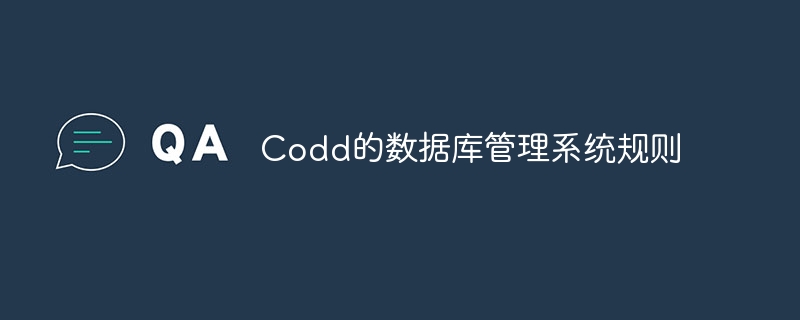

Edgar F. Codd, the pioneer of the relational model of databases, proposed a set of thirteen rules (numbered from zero to twelve) to determine the needs of a database management system What conditions must be met to be considered a relational database management system (RDBMS). They are also known as "Code's Twelve Commandments."
Any system that claims to be a relational database management system must be able to manage the database using only its relational capabilities.
The information in every relational database provides a clear logical representation through values in tables.
Ensure that every data (atomic value) in the relational database can be logically accessed by using a combination of table name, primary key value and column name.
In a fully relational database management system, the use of null values is supported to represent missing information and inapplicable information in a systematic way. Regardless of the data type, null values are associated with null characters, white space characters, zero and any Other integers are different.
Authorized users can query database descriptions using the same relational language that they use to query regular data, because database descriptions are logically stored in the same way as regular data.
Multiple languages and different terminal usage modes may be supported by the relational system (e.g., fill-in-the-blank mode). However, there must be at least one language that fully supports all of the above, and whose propositions can be expressed as strings of characters, following some well-defined syntax −
Data definition.
View definition.
Data manipulation (interactive and programmatic).
Integrity constraints.
Authorization.
Transaction boundaries (start, commit and rollback).
The system can update all views that may be updated.
The ability to handle base or derived relationships as a single operand, not only for data retrieval, but also for data insertion, update, and deletion.
Any modifications to storage representation or access technology will not logically affect application or terminal operations.
When any type of information-preserving changes are made to underlying tables, application and terminal operations remain logically unaffected.
The relational data sublanguage, rather than the application, must be able to define and store integrity constraints specific to a relational database.
The distribution of data between different sites must be hidden from end users. Data should not give users the impression that it is spread across multiple sites.
If a relational system has a low-level (record-by-record) language, the low-level language (multiple records) cannot be used to break or bypass the integrity restrictions and rules defined in the higher-level relational language.
According to Codd's database management system rules, no matter how the database is distributed in the network, it should work normally. End users should never know that data is spread across multiple sites; instead, they should always trust that data exists in only one location.
The above is the detailed content of Codd's Database Management System Rules. For more information, please follow other related articles on the PHP Chinese website!




